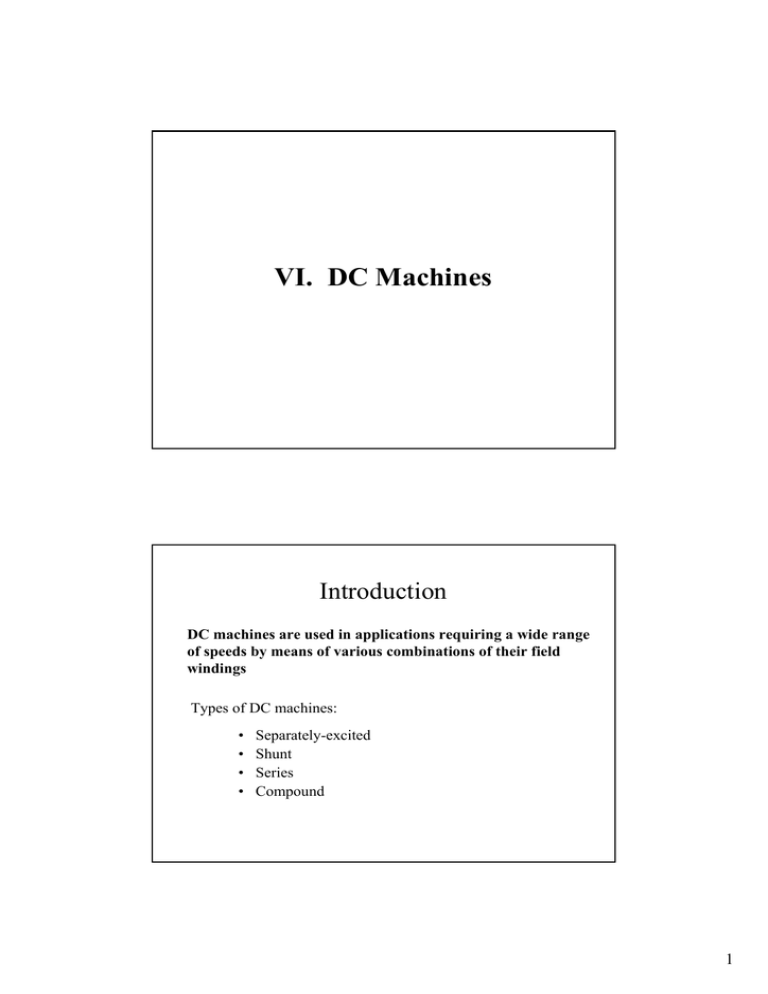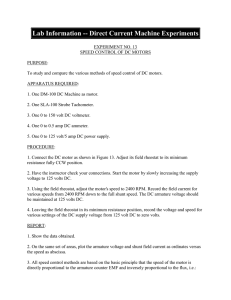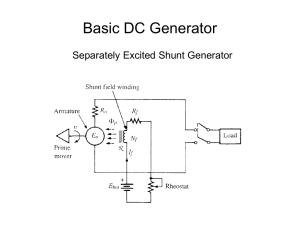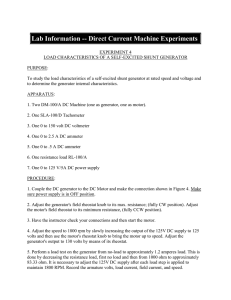Construction of DC Machines
advertisement

VI. DC Machines Introduction DC machines are used in applications requiring a wide range of speeds by means of various combinations of their field windings Types of DC machines: • • • • Separately-excited Shunt Series Compound 1 DC Machines Motoring Generating Mode Mode In Motoring Mode: Both armature and field windings are excited by DC In Generating Mode: Field winding is excited by DC and rotor is rotated externally by a prime mover coupled to the shaft 1. Construction of DC Machines Basic parts of a DC machine 2 Construction of DC Machines Copper commutator segment and carbon brushes are used for: (i) for mechanical rectification of induced armature emfs (ii) for taking stationary armature terminals from a moving member Elementary DC machine with commutator. (a) Space distribution of air-gap flux density in an elementary dc machine; Average gives us a DC voltage, Ea Ea = Kg f r Te = Kg f a = Kd If a (b) waveform of voltage between brushes. 3 Electrical Analogy (a) Space distribution of air-gap flux density in an elementary dc machine; (b) waveform of voltage between brushes. 2. Operation of a Two-Pole DC Machine 4 Space distribution of air-gap flux density, Bf in an elementary dc machine; One pole spans 180º electrical in space B f B peak sin( ) Mean air gap flux per pole: avg / pole Bavg A per Aper pole: surface area spanned by a pole pole 0 B peak sin( )dA 0 B peak sin( )rd For a two pole DC machine, avg / pole 2 B peak r Space distribution of air-gap flux density, Bf in an elementary dc machine; One pole spans 180º electrical in space B f B peak sin( ) Flux linkage a: with 0= 0 ea a Navg / pole cos( ) : phase angle between the magnetic axes of the rotor and the stator a Navg / pole cos( r t ) da r Navg / pole sin( r t ) dt For a two pole DC machine: Ea 2 (t ) r t 0 Ea 1 0 ea ( t )dt r Navg / pole 5 In general: Kg: winding factor E a K g f r f: mean airgap flux per pole r: shaft-speed in mechanical rad/sec r 2 nr nr: shaft-speed in revolutions per minute (rpm) 60 DC machines with number of poles > 2 f elec P nr Pnr 2 60 120 avg / pole Ea P: number of poles 2 2 B peak r P P 2 N r avg / pole K g f r 2 A four-pole DC machine Schematic representation of a DC machine 6 Typical magnetization curve of a DC machine Torque expression in terms of mutual inductance Te dM fa 1 2 dL f 1 2 dLa if ia i f ia 2 d 2 d d Te i f ia dM fa M fa M̂ cos d ˆi i Te M f a Alternatively, electromagnetic torque Te can be derived from power conversion equations Pmech Pelec Ea K g f m Te m Ea I a Te m K g f m I a Te K g f I a 7 In a linear magnetic circuit Te K g K f I f I a where f K f If Field-circuit connections of DC machines (a) separately-excited (c) shunt (b) series (d) compound 8 Separately-excited DC machine circuit in motoring mode Pmech Pout Pf & w internal electromechanical power or gross output power E a K g f m Kg E a Vt p Ca 2 a output power produced friction and windage p : number of poles Ca : total number of conductors in armature winding a : number of parallel paths through armature winding Te produces rotation (Te and m are in the same direction) Pmech 0, Te 0 and ωm 0 Separately-excited DC machine circuit in generating mode E a Vt Te and m are in the opposite direction Pmech 0, Te 0 and ωm 0 Generating mode – Field excited by If (dc) – Rotor is rotated by a mechanical prime-mover at m. – As a result Ea and Ia are generated 9 3. Analysis of DC Generators Separately-Excited DC Generator also Vt E a I a ra where E a K g f m Vt I L R L where I L Ia Terminal V-I Characteristics Terminal voltage (Vt) decreases slightly as load current increases (due to IaRa voltage drop) 10 Terminal voltage characteristics of DC generators Series generator is not used due to poor voltage regulation Shunt DC Generator (Self-excited DC Generator) – Initially the rotor is rotated by a mechanical prime-mover at m while the switch (S) is open. – Then the switch (S) is closed. 11 When the switch (S) is closed Ea= (ra + rf) If Load line of electrical circuit Self-excitation uses the residual magnetization & saturation properties of ferromagnetic materials. – when S is closed Ea = Er and If = If0 – interdependent build-up of If and Ea continues – comes to a stop at the intersection of the two curve as shown in the figure below Solving for the exciting current, If E a K g f m where f K f I f Ea K d If m where Kd K g K f Integrating with the electrical circuit equations K d i f m La Lf di f ra rf i f dt Applying Laplace transformation we obtain K d m I f ( s ) La Lf sI f ( s ) ra rf I f ( s ) La Lf I f0 So the time domain solution is given by if ( t ) I f0 r r K dm a f La Lf e t 12 if ( t ) I f0 r r K dm a f La Lf e t Let us consider the following 3 situations (i) (ra + rf) > Kdm lim if ( t ) 0 t Two curves do not intersect. (ii) (ra + rf) = Kdm if ( t ) I f 0 Self excitation can just start (iii) (ra + rf) < Kdm Generator can self-excite Self-excited DC generator under load Ia= If + IL Vt= Ea - ra Ia = rf If Ea= ra Ia + rf If Ea= (ra + rf) If + ra IL Load line of electrical circuit 13 Series DC Generator also Vt E a I a ( ra rs ) where E a K g f m Vt I L R L and I L Ia I s Not used in practical, due to poor voltage regulation Compound DC Generators (a) Short-shunt connected compound DC generator also Vt E a I a ra I s rs where E a K g f m Vt I L R L and IL Is and Ia If Is 14 (b) Long-shunt connected compound DC generator also Vt E a I a ra rs where E a K g f m Vt I L R L and I L Ia If and Ia Is Types of Compounding (i) Cumulatively-compounded DC generator (additive compounding) Fd Ff Fs field mmf shunt field mmf series field mmf for linear M.C. (or in the linear region of the magnetization curve, i.e. unsaturated magnetic circuits) d f s (ii) Differentially-compounded DC generator (subtractive compounding) Fd Ff Fs for linear M.C. (or in the linear region of the magnetization curve, i.e. unsaturated magnetic circuits) d f s Differentially-compounded generator is not used in practical, as it exhibits poor voltage regulation 15 Terminal V-I Characteristics of Compound Generators Above curves are for cumulatively-compounded generators Magnetization curves for a 250-V 1200-r/min dc machine. Also field-resistance lines for the discussion of self-excitation are shown 16 Examples 1. A 240kW, 240V, 600 rpm separately excited DC generator has an armature resistance, ra = 0.01 and a field resistance rf = 30. The field winding is supplied from a DC source of Vf = 100V. A variable resistance R is connected in series with the field winding to adjust field current If. The magnetization curve of the generator at 600 rpm is given below: If (A) 1 1.5 2 2.5 3 4 5 6 Ea (V) 165 200 230 250 260 285 300 310 If DC generator is delivering rated load and is driven at 600 rpm determine: a) Induced armature emf, Ea b) The internal electromagnetic power produced (gross power) c) The internal electromagnetic torque d) The applied torque if rotational loss is Prot = 10kW e) Efficiency of generator f) Voltage regulation 2. A shunt DC generator has a magnetization curve at nr = 1500 rpm as shown below. The armature resistance ra = 0.2 , and field total resistance rf = 100 . a) Find the terminal voltage Vt and field current If of the generator when it delivers 50A to a resistive load b) Find Vt and If when the load is disconnected (i.e. no-load) 17 Solution: a) b) NB. Neglected raIf voltage drops 3. The magnetization curve of a DC shunt generator at 1500 rpm is given below, where the armature resistance ra = 0.5 , and field total resistance rf = 100 , the total friction & windage loss at 1500 rpm is 400W. a) Find no-load terminal voltage at 1500 rpm b) For the self-excitation to take place (i) Find the highest value of the total shunt field resistance at 1500 rpm (ii) The minimum speed for rf = 100. c) Find terminal voltage Vt, efficiency and mechanical torque applied to the shaft when Ia = 60A at 1500 rpm. 18 Solution: a) b) (i) b) (ii) 4. Analysis of DC Motors DC motors are adjustable speed motors. A wide range of torquespeed characteristics (Te-m) is obtainable depending on the motor types given below: • • • • Series DC motor Separately-excited DC motor Shunt DC motor Compound DC motor 19 DC Motors Overview (a) Series DC Motors (b) Separately-excited DC Motors 20 (c) Shunt DC Motors (d) Compound DC Motors 21 DC Motors (a) Series DC Motors The back e.m.f: E a K g f m Electromagnetic torque: Te K g f I a Terminal voltage equation: Vt E a I a ( ra rs ) Ia I s Assuming linear equation: f K f Is Te K g f I a f K f Is Te K g K f I s I a Ia I s Te K d I a2 K g f K d I a m Ea V I a ra rs t K g f K g f E a K g f m , Vt E a I a ( ra rs ) m Vt I a ra rs K d Ia K g f K d I a E a K d I a m Vt I a ra rs Ia Te E a K g f m Vt K d m ra rs K d Vt 2 K d m ra rs 2 Te K d I a2 22 Te K d Vt 2 K d m ra rs 2 thus Te 1 m2 Note that: A series DC motor should never run no load! Te 0 m overspeeding! (b) Separately-excited DC Motors The back e.m.f: E a K g f m Electromagnetic torque: Te K g f I a Terminal voltage equation: Vt E a I a ra Assuming linear equation: f K f If 23 Vt E a I a ra Vt K g f m Te ra K g f Vt Te ra m K g f K g f 2 ra Vt K g f K g f 2 m E a K g f m , Te Te K g f I a m 0 K l Te No load (i.e. Te = 0) speed: 0 Slope: Kl ra K g f 2 Vt K g f very small! Slightly dropping m with load (c) Shunt DC Motors The back e.m.f: E a K g f m Electromagnetic torque: Te K g f I a Terminal voltage equation: Vt E a I a ra Assuming linear equation: f K f If 24 Vt E a I a ra Vt K g f m Te ra K g f Vt Te ra m K g f K g f 2 ra Vt K g f K g f 2 m E a K g f m , Te Te K g f I a m 0 K l Te Same as separately excited motor No load (i.e. Te = 0) speed: 0 Slope: Kl Vt K g f ra K g f 2 very small! Slightly dropping m with load m 0 K l Te Note that: In the shunt DC motors, if suddenly the field terminals are disconnected from the power supply, while the motor was running, overspeeding problem will occur E a K g f m so f 0 m Ea is momentarily constant, but f will decrease rapidly. overspeeding! 25 Motor Speed Control Methods (a) Controlling separately-excited DC motors Shaft speed can be controlled by i. Changing the terminal voltage ii. Changing the field current (magnetic flux) i. Changing the terminal voltage m 0 K l Te Te K g f I a 0 Vt K g f Vt 0 , Vt E a I a ra Te 26 ii. Changing the field current m 0 K l Te Te K g f I a f K f I f 0 Vt K g f (linear magnetic circuit) I f f , 0 , Te (b) Controlling series DC motors Shaft speed can be controlled by i. Adding a series resistance ii. Adding a parallel field diverter resistance iii. Using a potential divider at the input (i.e. changes the effective terminal voltage) 27 i. Adding a series resistance For the same Te produced Ea drops, Ia stays the same E a Vt I a ( ra rs rt ) For the same Te, f is constant but m drops since Ea = Kg f m.. New value of the motor speed, m is given by m Ea K g f rt ii. Te K g f I a E a K g f m Ea , m Adding a parallel field diverter resistance When we add the diverter resistance Is drops i.e. Is < Ia. Ea remains constant, For the same Te produced, Ia increases Ia Vt E a ra ( rs || rd ) rs || rd rs When series field flux drops, the motor speed m = Ea / Kg f should rise, while driving the same load. m rd Ea K g f I s , E a K g f m f K f Is I a , f , m 28 iii. Using a potential divider Let us apply Thévenin theorem to the right of Vt VTh R2 Vt R1 R2 RTh R1 || R2 This system like the speed control by adding series resistance as explained in section (i) where rt RTh and Vt VTh. For the same Te produced Ea drops rapidly, Ia stays the same E a VTh I a ( ra rs RTh ) For the same Te, f is constant but m drops rapidly since Ea = Kg f m.. New value of the motor speed, m is given by Ea Te K g f I a m K g f E K a Vt g f m E a , m If the load increases, Te and Ia increases and Ea decreases, thus motor speed m drops down more. Ex1: A separately excited DC motor drives the load at nr = 1150 rpm. a) Find the gross output power (electromechanical power output) produced by the DC motor. b) If the speed control is to be achieved by armature voltage control and the new operating condition is given by: nr = 1000 rpm and Te = 30 Nm find the new terminal voltage Vt while f is kept constant. 29 Soln: a) Gross output power is given by Pconv Te m Ea I a For Ia = 36 A Ea VT I a ra 125 36 0.37 112 V Thus Pconv Te m Ea I a 112 36 4.03 kW Note that induced torque is found to be Te = 33.4 Nm b) New gross output power is found to be Pconv2 Te 2 m 2 Ea 2 I a 2 30 2 1000 / 60 3.14 kW As Ea = Kg f m and f is constant Ea 2 nr 2 1000 E a1 112 97.1 V nr 1 1150 Ea1 m1 nr 1 Ea 2 m 2 nr 2 Then, new armature current is found to be Ia 2 Pconv 2 3.14k 32.3 A Ea 2 97.1 Consequently, the new terminal voltage is given by Vt Ea 2 I a 2 ra 97.1 32.3 0.37 109 V 30 Ex2: A 50 hp, 250 V, 1200 rpm DC shunt motor with compensating windings has an armature resistance (including the brushes, compensating windings, and interpoles) of 0.06 . Its field circuit has a total resistance Radj + RF of 50 , which produces a no-load speed of 1200 rpm. The shunt field winding has 1200 turns per pole. a) Find the motor speed when its input current is 100 A. b) Find the motor speed when its input current is 200 A. c) Find the motor speed when its input current is 300 A. d) Plot the motor torque-speed characteristic. Solution: At no load, the armature current is zero and therefore Ea = VT = 250 V. a) Since the input current is 100 A, the armature current is I A IL IF IL VT 250 100 95 A RF 50 Therefore E A VT I A RA 250 95 0.06 244.3V and the resulting motor speed is: n2 EA2 244.3 n1 1200 1173rpm E A1 250 31 b) Similar computations for the input current of 200 A lead to n2 = 1144 rpm. c) Similar computations for the input current of 300 A lead to n2 = 1115 rpm. d) At no load, the torque is zero. For the input current of 100 A: ind For the input current of 200 A: ind For the input current of 300 A: ind The induced torque is ind 2443 95 190N - m 2 1173 / 60 2383 195 388N - m 2 1144 / 60 2323 295 587 N - m 2 1115 / 60 EA I A The torque-speed characteristic of the motor is: Ex3: A 100 hp, 250 V, 1200 rpm DC shunt motor with an armature resistance of 0.03 and a field resistance of 41.67 . The motor has compensating windings, so armature reactance can be ignored. Mechanical and core losses may be ignored also. The motor is driving a load with a line current of 126 A and an initial speed of 1103 rpm. Assuming that the armature current is constant and the magnetization curve is a) What is the motor speed if the field resistance is increased to 50 ? b) Calculate the motor speed as a function of the field resistance, assuming a constant-current load. c) Assuming that the motor next is connected as a separately excited and is initially running with VA = 250 V, IA = 120 A and at n = 1103 rpm while supplying a constant-torque load, estimate the motor speed if VA is reduced to 200 V. 32 Soln: shunt a) For the given initial line current of 126 A, the initial armature current will be I A1 I L1 I F 1 126 250 120 A 41.67 Therefore, the initial generated voltage for the shunt motor will be E A1 VT I A1 RA 250 120 0.03 246.4V After the field resistance is increased to 50 Ω, the new field current will be IF 2 250 5 A 50 The ratio of the two internal generated voltages is E A 2 K22 2 n2 E A1 K11 1n1 Since the armature current is assumed constant, EA1 = EA2 and, therefore n2 1n1 2 The values of EA on the magnetization curve are directly proportional to the flux. Therefore, the ratio of internal generated voltages equals to the ratio of the fluxes within the machine. From the magnetization curve, at IF = 5A, EA1 = 250V, and at IF = 6A, EA1 = 268V. Thus: n2 1n1 E A1n1 268 1103 1187rpm 250 2 EA2 b) A speed vs. RF characteristic is shown on the right 33 separately excited c) For a separately excited motor, the initial generated voltage is E A1 VT 1 I A1 RA Since E A 2 K22 2 n2 E A1 K11 1n1 and since the flux is constant E n n2 A 2 1 E A1 Since the both the torque and the flux are constants, the armature current IA is also constant. Then n2 VT 2 I A2 RA 200 120 0.03 1103 879rpm n1 250 120 0.03 VT 1 I A1 RA Ex4: A 250-V series dc motor with compensating windings. and a total series resistance ra + rs of 0.08 . The series field consists of 25 turns per pole. with the magnetization curve (at 1200 rpm) shown below. a) Find the speed and induced torque of this motor for when its armature current is 50 A. b) Calculate the efficiency of the motor 34 Soln: a) To analyze the behavior of a series motor with saturation. pick points along the operating curve and find the torque and speed for each point. Notice that the magnetization curve is given in units of magnetomotive force (ampere-turns) versus Ea for a speed of 1200 r/min. so calculated Ea values must be compared to the equivalent values at 1200 r /min to deternine the actual motor speed. For Ia = 50 A Ea VT I a ra rs 250 50 0.08 246 V Since Ia = Is = 50 A. the magnetomotive force is Fs NI s 25 50 1250 A - turns From the magnetization curve at F = 1250 A-turns. Ea0 = 80 V. To get the correct speed of the motor. nr Ea 246 nr 0 1200 3690 rpm Ea 0 80 To find the induced torque supplied by the motor at that speed, recall that Pconv = Ea Ia = Tem. Therefore, Te b) Ea I a m 246 50 31.8 Nm 2 3690 / 60 Efficiency is given by the ratio of the output and input power values. Thus, % 246 50 Pout T E I 100 e m 100 a a 100 100 98.4% 250 50 Pin Vt I t Vt I t 35



